What Is HAARP?
The High-frequency Active Auroral Research Program (HAARP) is the world’s most capable high-power, high-frequency (HF) transmitter for the study of the ionosphere. The principal instrument is the Ionospheric Research Instrument (IRI), a phased array of 180 HF crossed-dipole antennas spread across 33 acres and capable of radiating 3.6 megawatts into the upper atmosphere and ionosphere. Transmit frequencies are selectable in the range of 2.7 to 10 MHz, and since the antennas form a sophisticated phased array, the transmitted beam can take many shapes, can be scanned over a wide angular range, and multiple beams can be formed. The facility uses 30 transmitter shelters, each with six pairs of 10 kilowatt transmitters, to achieve the 3.6 MW transmit power.
HAARP has been operational for several decades:
- Early Operations (1990s): Construction of the full HAARP facility began in the early 1990s, and it became fully operational around 2007.
- Transfer to UAF (2015): As mentioned, the facility was transferred from military control to the University of Alaska Fairbanks in August 2015. Since then, it has continued to operate as a cutting-edge scientific research facility, open to researchers from around the world to submit proposals for ionospheric experiments.
Therefore, HAARP has been active for many years.
To learn about HAARP, read the articles linked below.
Most people never even heard of HAARP, but the fact is, HAARP installations exist and are most likely than not, responsible for a lot of foul weather and earthquakes in the past 15 years. Investigate and you will find the facts. Or just stay ignorant and blissful. It’s up to you.
Your Country/family/friends/patriots, fellow human beings, nature, and our Mother Earth need you to “WAKE UP”. This weapon was brought into the world over a hundred years ago by Nikola Tesla and patented by Bernard Eastlund. US PATENT #4,686,605
Jeff Rense
Note from Leuren Moret…
1-8-11
Hi Jeff…
I identified the HAARP sites two years ago. They left some key ones out: Chile (HAARP earthquake as President was sworn in), Cyprus (Black Sea Storm), Dushanbe Tajikistan (Tien Shan gold belt), and ANTARCTICA – the most important one. Plus, they forgot all the Russian installations, more than any other country.
Here are the main mining projects of Eurasian Mining Company Inc., which are all located where mining riches are located, “Bill Clinton Uranium Scandal” was started by Frank Giustra, who flies around the world with Bill Clinton to secure mining contracts in these key places after Clinton introduces him to the Pres. of the country he wants to mine in.
http://www.eurasianminerals.com/s/Home.asp
http://www.businessinsider.com/major-bill-clinton-ally-and-donor-in-kazakhstan-uranium-scandal-2009-5
After the contracts are signed in each country, Giustra forks over $150 million to Clinton’s foundation. Wasn’t Clinton involved in Haiti, etc, etc, where all this mineral loot is?
http://www.google.com/search?q=clinton+%2B+giustra&rls=com.microsoft:en-us&ie=UTF-8&oe=UTF-8&startIndex=&startPage=1
THE HAARP SITES ARE LOCATED GLOBALLY WHERE THE RICHEST MINERAL BELTS ARE LOCATED. SUBSURFACE MINERAL EXPLORATION HAS BEEN DONE FROM SATELLITES BY RADIOTOMOGRAPHY, WHICH IS 100% ACCURATE.
HAARP is so powerful, it can create an artificial aurora high in the sky. The research has the potential to improve satellite communications and navigation. And, yes, the military has used it to study things they don’t talk about.
- Fallen’s research on the “Luxembourg effect” involved mixing two different audio signals using HAARP, producing unique auditory results that may not aid in improving public perception.
- Plans to use simpler musical compositions in future experiments were mentioned, but are uncertain due to the impending closure.
Luxembourg Effect
(or cross modulation), a phenomenon in which, during reception of the radio waves of a radio station operating on a carrier frequency f1, a broadcast of another strong radio station that is in line with it and is operating on a carrier frequency f2 that is significantly different from f3 can be heard. The Luxembourg effect was first observed in 1933 at Eindhoven (Netherlands), where the powerful Radio Luxembourg station, located in line with a Swiss station, could be heard during the Swiss broadcast. A similar phenomenon was observed in the city of Gorky, where powerful Moscow stations could be heard during the reception of radio stations located to the west of Moscow.
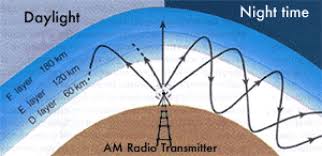
Ref: https://swling.com/blog/2022/11/radio-physics-explained-the-luxemburg-gorky-effect/
While the term “HAARP” specifically refers to the Alaska facility, various countries around the world operate similar, though often distinct, types of facilities for studying ionospheric phenomena. These installations include:
- Incoherent Scatter Radars (ISRs): These powerful radars transmit electromagnetic pulses into the ionosphere and detect the faint signals scattered back by the free electrons in the plasma. By analyzing these signals, scientists can determine ionospheric properties like electron density, temperature, and plasma velocity.
- Radio Observatories and Telescopes: Many radio observatories, while primarily used for astronomical research, also conduct studies of the ionosphere as it affects radio signals passing through it.
- VLF/ELF Transmitters: Very Low Frequency (VLF) and Extremely Low Frequency (ELF) transmitters are used to study the lower ionosphere and its interaction with the Earth’s magnetic field.
- Heating Facilities: Facilities explicitly designed to “heat” or “modify” the ionosphere (similar to HAARP but often with different specifications) exist in various locations for controlled experiments.
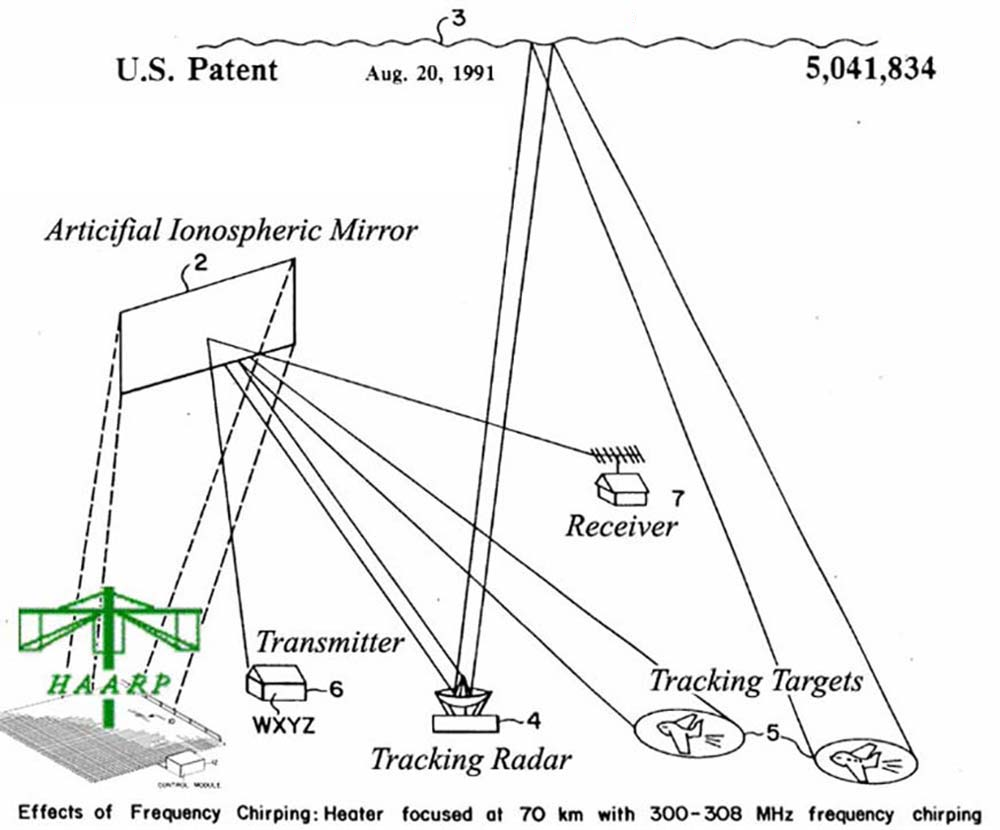
Here are the lists of the GPS coordinates for the 20 top HAARP (High Frequency Active Auroral Research Program) facilities around the world. The facilities are located in Alaska, Colorado, Massachusetts, Puerto Rico, Peru, Brazil, Wales, Norway, Russia, Ukraine, India, China, Japan, Australia, and Antarctica. They include research stations, radar arrays, radio observatories, and other installations for studying ionospheric phenomena.
1- High Frequency Active Auroral Research Program (HAARP) Gakona, Alaska +62° 23′ 30.00″, -145° 8′ 48.00″
2- High Power Auroral Stimulation Observatory (HIPAS) Fairbanks, Alaska 64° 52′ 19″ N 146° 50′ 33″ W
3- Poker Flat Research RangeNear Chatanika, Alaska +65° 7′ 23.90″, -147° 28′ 7.05″
4- Platteville Atmospheric Observatory Platteville, Colorado +40° 10′ 54″, -104° 43′ 30″
5- Millstone Hill Radio Observatory Westford, Massachusetts +42° 37′ 09.25″, -71° 29′ 28.49″
6- The Arecibo Observatory radio telescope Arecibo Puerto Rico.18°20’38.97″N 66°45’9.77″W
7- Jicamarca Radio Observatory Lima, Peru 11° 57′ 08.25″ S 76° 52′ 30.67″ W
8- São Luiz Space ObservatoryCruzeiro Santa Bárbara, Sao Luis-MA, Brasil -2° 35′ 40.47″, -44° 12′ 35.90″
9- Nerc MST Radar FacilityCapel Dewi, Carmarthenshire, Wales, United Kingdom +52° 25′ 28.26″, -4° 00′ 19.59″
10- European Incoherent Scatter Scientific Association EISCAT Ramfjordmoen, Near Tromsø, Norway +69° 35′ 10.94″, +19° 13′ 20.89″
11- Sura FacilityNizhniy Novgorod, Russia +56° 7′ 9.70″, +46° 2′ 3.66″
12- The Russian Woodpecker Duga Radar Array, Chernobyl, Ukraine 51°18’20.17″N, 30°04’02.60″E
13- National MST Radar Facility, NMRF Gadanki, India +13° 27′ 26.68″, +79° 10′ 30.74″
14- China Research Institute of Radiowave Propagation (CRIRP) Xinjiang (Sinkiang) Region 40°24’15.91″N, 93°38’09.74″E
15- Sheshan, Shanghai, China 31°5′41.98′′N, 121°11′29.72′′E
16- Mu Radarin Japan 34°51’14.80″N 136° 6’19.45″E
17- Jindalee Operational Radar Network (JORN) Laverton, West Australia-28° 19′ 36.29″, +122° 0′ 18.84″
18- Jindalee Operational Radar Network (JORN) Longreach, Queensland, Australia-23° 39′ 29.53″, +144° 8′ 49.58″
19- Australia Naval Communications Station Harold E Holt (NCS HEH) Exmouth, Western Australia. 21° 48′ 59.47″s, 114° 09′ 55.60″
20- Zhong Shan Antarctic Polar Station (China) 69o 22′ 43.69″ S 76o 23′ 15.07″ E
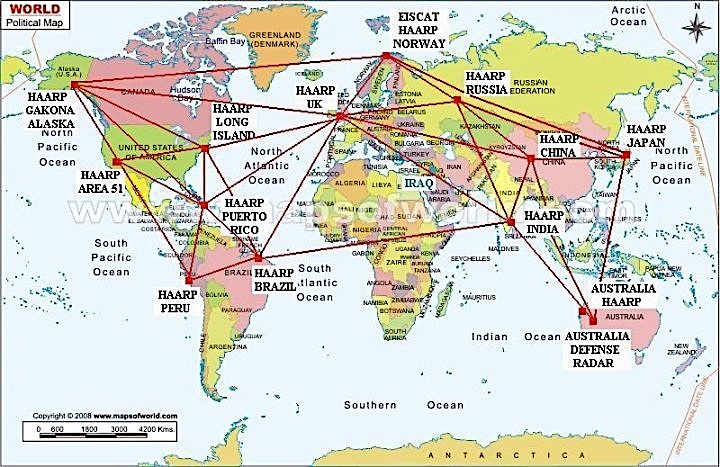
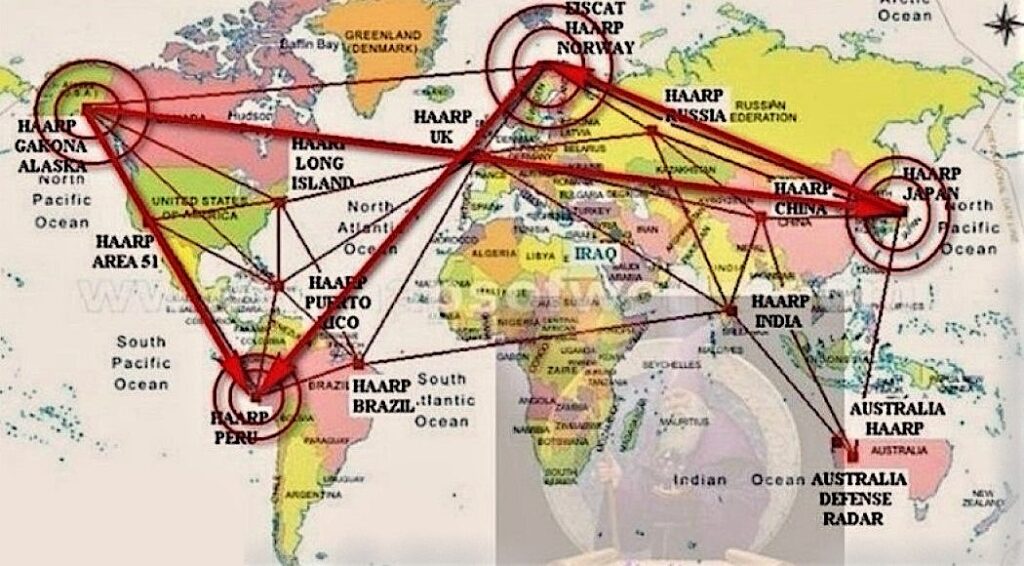
Coordinates in GPS format for 20 major HAARP installations across the globe, along with a brief explanation of their objectives and significance.
- HAARP Research Station, Alaska, USA (62.3569° N, 145.0681° W) Located near Gakona, Alaska, the HAARP Research Station is one of the most well-known and well-equipped facilities for studying the ionosphere. It features a powerful transmitter array capable of generating high-frequency radio waves, which can be used to probe and manipulate the ionosphere.
- Arecibo Observatory, Puerto Rico (18.3484° N, 66.7574° W) The Arecibo Observatory is a radio telescope facility in Puerto Rico that has been used for various ionospheric research projects, including collaborations with the HAARP program. Its massive 305-meter (1,000-foot) radio telescope allows for detailed observations of the ionosphere and other celestial phenomena.
- Sura Ionospheric Heating Facility, Russia (54.7941° N, 40.5561° E) The Sura Ionospheric Heating Facility is located near the city of Vasilsursk, Russia, and is one of the largest ionospheric research facilities in the world. It features a powerful transmitter array capable of generating radio waves with frequencies up to 20 MHz.
- EISCAT Svalbard Radar, Norway (78.1403° N, 16.0121° E) The EISCAT Svalbard Radar is a powerful radar facility located on the Norwegian archipelago of Svalbard. It is used for studying the ionosphere, as well as for monitoring space weather and detecting meteors.
- Jicamarca Radio Observatory, Peru (11.9482° S, 76.8694° W) The Jicamarca Radio Observatory is an ionospheric research facility located near Lima, Peru. It features a powerful radar system that can be used to study the ionosphere, as well as to detect earthquakes and other natural disasters.
- Poker Flat Research Range, Alaska, USA (65.1375° N, 147.4095° W) The Poker Flat Research Range is a rocket launch facility located near Fairbanks, Alaska, that has been used for various ionospheric research projects, including collaborations with the HAARP program. It is particularly well-suited for studying the aurora borealis and other atmospheric phenomena.
- Millstone Hill Radar Observatory, Massachusetts, USA (42.6348° N, 71.5522° W) The Millstone Hill Radar Observatory is a research facility located near Westford, Massachusetts, that is used for studying the ionosphere and other atmospheric phenomena. It features a powerful radar system that can be used to probe the ionosphere and to detect space weather events.
- HAARP Antenna Array, Colorado, USA (39.7228° N, 105.1941° W) The HAARP Antenna Array is a research facility located near Platteville, Colorado, that is used for studying the ionosphere and other atmospheric phenomena. It features a powerful transmitter array capable of generating radio waves with frequencies up to 10 MHz.
- EISCAT VHF Radar, Norway (69.6416° N, 19.2117° E) The EISCAT VHF Radar is a powerful radar facility located near Tromsø, Norway, that is used for studying the ionosphere and other atmospheric phenomena. It is particularly well-suited for studying the aurora borealis and other atmospheric phenomena.
- ALOMAR Observatory, Norway (69.3494° N, 16.0028° E) The ALOMAR Observatory is a research facility located near the city of Andenes, Norway, that is used for studying the ionosphere and other atmospheric phenomena. It features a powerful radar system that can be used to probe the ionosphere and to detect space weather events.
- GIANT Radar, Brazil (23.4818° S, 46.3876° W) The GIANT Radar is a powerful radar facility located near the city of Cachoeira Paulista, Brazil, that is used for studying the ionosphere and other atmospheric phenomena. It is particularly well-suited for studying the aurora australis and other atmospheric phenomena.
- EISCAT UHF Radar, Sweden (68.3556° N, 19.0253° E) The EISCAT UHF Radar is a powerful radar facility located near the city of Kiruna, Sweden, that is used for studying the ionosphere and other atmospheric phenomena. It is particularly well-suited for studying the aurora borealis and other atmospheric phenomena.
- HAARP Antenna Array, Massachusetts, USA (42.6434° N, 71.5558° W) The HAARP Antenna Array is a research facility located near Westford, Massachusetts, that is used for studying the ionosphere and other atmospheric phenomena. It features a powerful transmitter array capable of generating radio waves with frequencies up to 10 MHz.
- European Incoherent Scatter Scientific Association (EISCAT) Radar, Finland (67.5722° N, 24.1983° E) The EISCAT Radar is a powerful radar facility located near the city of Sodankylä, Finland, that is used for studying the ionosphere and other atmospheric phenomena. It is particularly well-suited for studying the aurora borealis and other atmospheric phenomena.
- Jicamarca Radio Observatory, Peru (11.9482° S, 76.8694° W) The Jicamarca Radio Observatory is an ionospheric research facility located near Lima, Peru. It features a powerful radar system that can be used to study the ionosphere, as well as to detect earthquakes and other natural disasters.
- EISCAT East Radar, Finland (67.8694° N, 24.1983° E) The EISCAT East Radar is a powerful radar facility located near the city of Sodankylä, Finland, that is used for studying the ionosphere and other atmospheric phenomena. It is particularly well-suited for studying the aurora borealis and other atmospheric phenomena.
- Millstone Hill Radar Observatory, Massachusetts, USA (42.6348° N, 71.5522° W) The Millstone Hill Radar Observatory is a research facility located near Westford, Massachusetts, that is used for studying the ionosphere and other atmospheric phenomena. It features a powerful radar system that can be used to probe the ionosphere and to detect space weather events.
- HAARP Antenna Array, Alaska, USA (62.3569° N, 145.0681° W) The HAARP Antenna Array is a research facility located near Gakona, Alaska, that is used for studying the ionosphere and other atmospheric phenomena. It features a powerful transmitter array capable of generating radio waves with frequencies up to 10 MHz.
- ALOMAR Observatory, Norway (69.3494° N, 16.0028° E) The ALOMAR Observatory is a research facility located near the city of Andenes, Norway, that is used for studying the ionosphere and other atmospheric phenomena. It features a powerful radar system that can be used to probe the ionosphere and to detect space weather events.
- EISCAT Svalbard Radar, Norway (78.1403° N, 16.0121° E) The EISCAT Svalbard Radar is a powerful radar facility located on the Norwegian archipelago of Svalbard. It is used for studying the ionosphere, as well as for monitoring space weather and detecting meteors.
August 8, 2025: HAARP Conducted Research Campaign
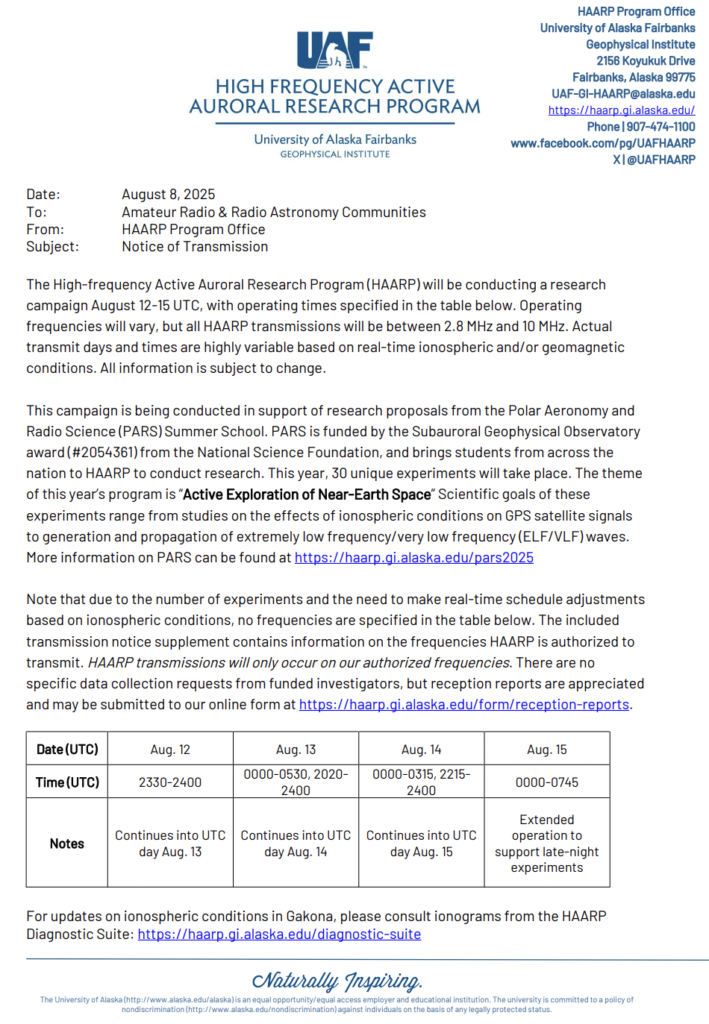
July 21, 2025:
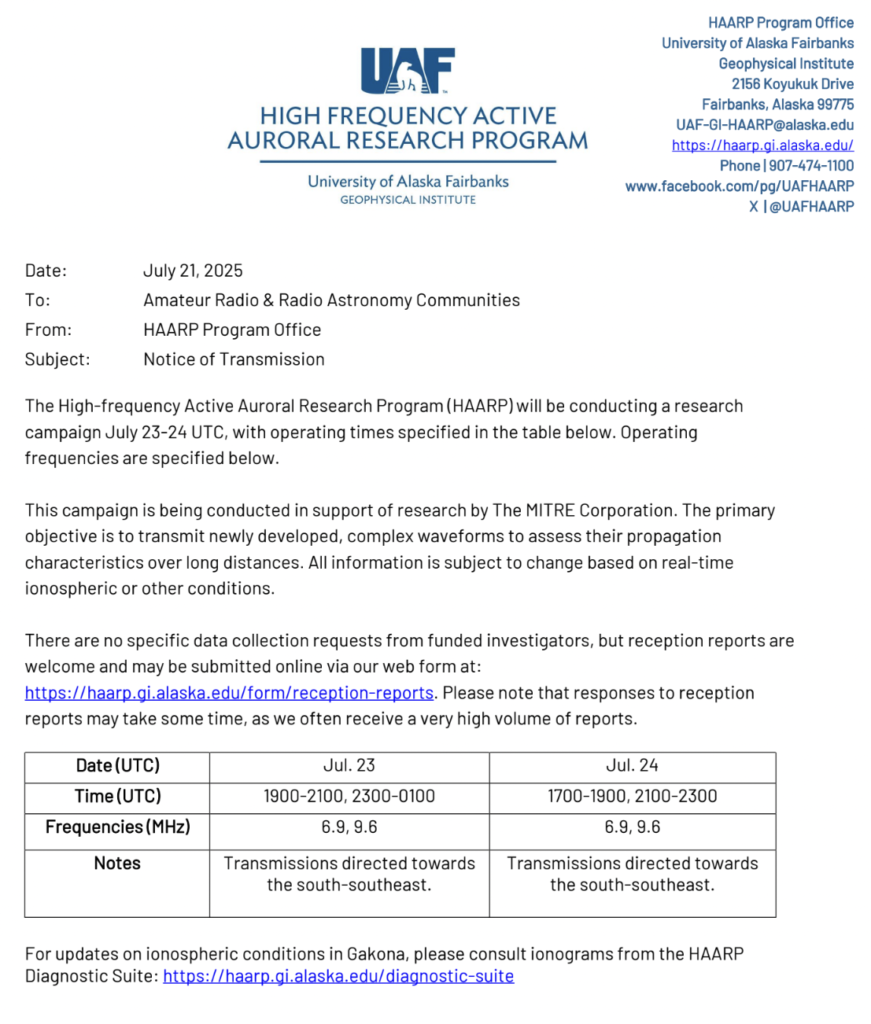
HAARP Research Campaign Announcement
The High-frequency Active Auroral Research Program (HAARP) conducted a research campaign on July 23-24, 2025. This initiative is intended to support a study by The MITRE Corporation.
The main goal is to transmit newly developed complex waveforms to assess their propagation characteristics over long distances.
- Operating Times and Frequencies:
- July 23, 2025:
- Time: 1900-2100 UTC, 2300-0100 UTC
- Frequencies: 6.9 MHz, 9.6 MHz
- July 24, 2025:
- Time: 1700-1900 UTC, 2100-2300 UTC
- Frequencies: 6.9 MHz, 9.6 MHz
- Direction: Transmissions will be directed south-southeast.
- July 23, 2025:
- Ionospheric Conditions: All information regarding the campaign may change based on real-time ionospheric conditions. For updates, stakeholders can refer to the HAARP Diagnostic Suite for ionograms at HAARP Diagnostic Suite.
- Reception Reports: While there are no specific data collection requests from investigators, reception reports from the ham radio community are encouraged. Reports can be submitted online via a designated web form available at HAARP Reception Reports. Note that responses may take time due to high volume.
- Additional Resources:
- An educational video on HF propagation and understanding ionograms can be found here: Understanding HF Propagation.
- A simplified guide to reading ionograms by John (VE6EY) is available at: Reading Your Ionogram – Keeping It Simple.
Recent Updates in Amateur Radio
- Bochum Space Days 2025: Focused amateur radio space projects (August 13, 2025).
- HamCation Awards Nominations: Seeking nominations for new categories, including Amateur Radio Hero of the Year for the 2026 season (August 12, 2025).
- Hams Over IP: Encourages Hamshack Hotline users to apply for a VoIP alternative (August 11, 2025).
- US Congressional Candidate: WX3SVR is campaigning on amateur radio-related issues (August 10, 2025).
- Zero Retries Digital Conference: Event dedicated to technology in amateur radio (August 9, 2025).
- Polish Amateur Radio Union: Celebrates three Polish lighthouses with a nine-day commemorative event (August 9, 2025).
Ref:
- https://www.scribd.com/doc/47408702/HAARP-Locations-Worldwide-Map
- https://encyclopedia2.thefreedictionary.com/Luxembourg+Effect
- http://www.rense.com/general92/haarp.htm
- http://patft.uspto.gov/netacgi/nph-Parser?Sect2=PTO1&Sect2=HITOFF&p=1&u=/netahtml/PTO/search-bool.html&r=1&f=G&l=50&d=PALL&RefSrch=yes&Query=PN/4686605
- https://www.wshu.org/vintage-radio/2018-02-08/the-luxembourg-effect
- Wikipedia, Facebook
